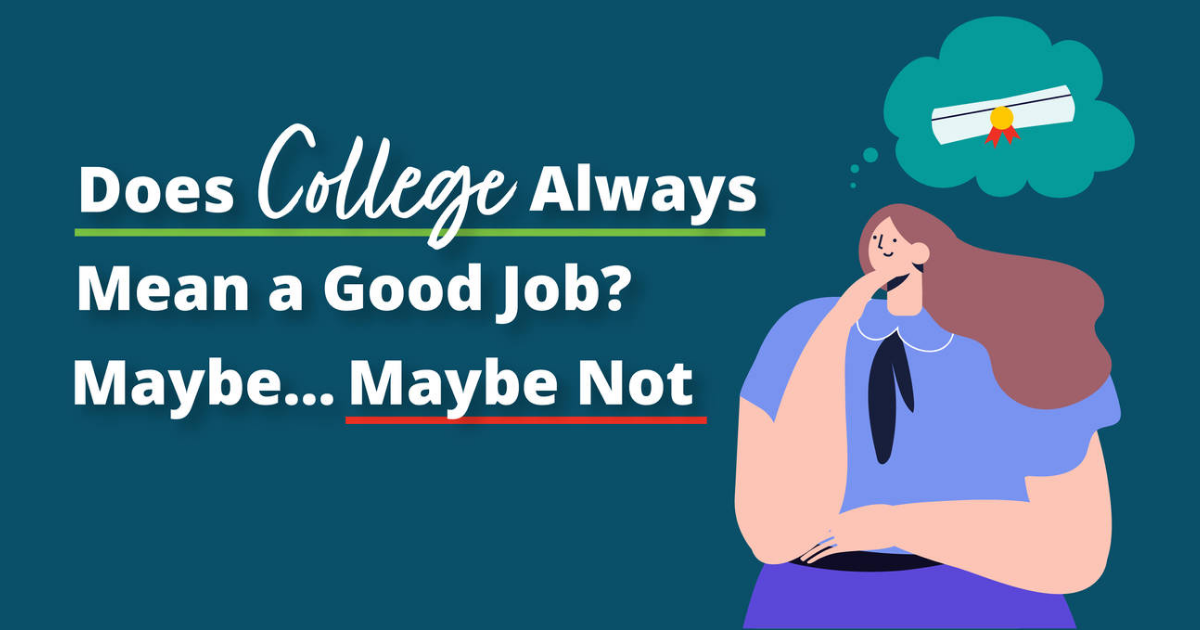
Does College Always Mean a Good Job? Maybe… Maybe Not
Looking for a job definitely tops the list of stressful things to do. Yet 83% of HR professionals had a tough time finding qualified applicants in 2018.1 So what can job-seekers do now to qualify for their next big break?
Many people can score high paying jobs without a degree.2 First, lay a solid foundation with skills like reading, writing and speaking—they are essential to over 90% of employers!3 Some free online classes never hurt either. In fact, just six hours of free online training can qualify applicants to become a contact tracer and earn $17-25 per hour.4
Then, consider getting a higher degree or certificate to earn a higher wage, or even get an interview. A two-year associate degree is basically the lifespan of an iPhone5, with many more benefits—like a much lower unemployment rate!6
For some careers like teaching or accounting, investing in a four-year degree might be the best option. Even though new debt is intimidating, record low interest rates on new student loans in Fall 2020 could make college more affordable for some.7
And good news! Some of the fastest-growing jobs in the U.S. (like Occupational Therapy Assistants) also pay pretty awesome.8 With the relevant training, job seekers can boost their chances of landing one of those jobs later. Then, they can crush their financial goals with a sweet, sweet paycheck.
But going back to school is not for everyone. That’s why a work-based learning program can be a good path, like an apprenticeship through an American Job Center or a labor union. And the pay even compares with some healthcare jobs with a $70K starting salary!9
The point is, training for a new job is not one size fits all. Job-seekers can choose from different training options—from basic education to a college degree—to boost their next job application and find financial success.
Visual person? Check out the infographic below to explore your training and career options.

Sources:
1SHRM Staff. (2019, February 5). The Skills Gap 2019. Retrieved from the Society for Human Resource Management: https://www.shrm.org/hr-today/trends-and-forecasting/research-and-surveys/pages/skills-gap-2019.aspx
2CareerOneStop Staff. (n.d.) Fastest-Growing Careers. Retrieved from CareerOneStop: https://www.careeronestop.org/toolkit/careers/fastest-growing-careers.aspx?persist=true&location=US
3NACE Staff. (n.d.). Career Readiness Competencies: Employer Survey Results. Retrieved from National Association of Colleges and Employers: https://www.naceweb.org/career-readiness/competencies/career-readiness-competencies-employer-survey-results/
4Dill, K. (2020, May 21). What It Takes to Become a Contact Tracer on the Trail of the Coronavirus. Retrieved from The Wall Street Journal: https://www.wsj.com/articles/what-it-takes-to-become-a-contact-tracer-on-the-trail-of-the-coronavirus-11590102932?mod=searchresults&page=1&pos=4
5Ng, A. (2019, May 16). Smartphone users are waiting longer before upgrading – here’s why. Retrieved from CNBC: https://www.cnbc.com/2019/05/17/smartphone-users-are-waiting-longer-before-upgrading-heres-why.html
6Bureau of Labor Statistics Staff. (n.d.) Unemployment rates and earnings by educational attainment. Retrieved from U.S. Bureau of Labor Statistics: https://www.bls.gov/emp/chart-unemployment-earnings-education.htm
7Dickler, J. (2020, May 12). Federal student loan rates hit record lows. Retrieved from CNBC: https://www.cnbc.com/2020/05/12/federal-student-loan-rates-hit-record-lows.html
8CareerOneStop Staff. (n.d.) Occupational Therapy Assistants. Retrieved from CareerOneStop: https://www.careeronestop.org/toolkit/careers/occupations/Occupation-profile.aspx keyword=Occupational%20therapy%20assistants&location=US&onetcode=31201100
9Apprenticeship Staff. (n.d.) Why Become an Apprentice. Retrieved from Apprenticeship.gov: https://www.apprenticeship.gov/become-apprentice


